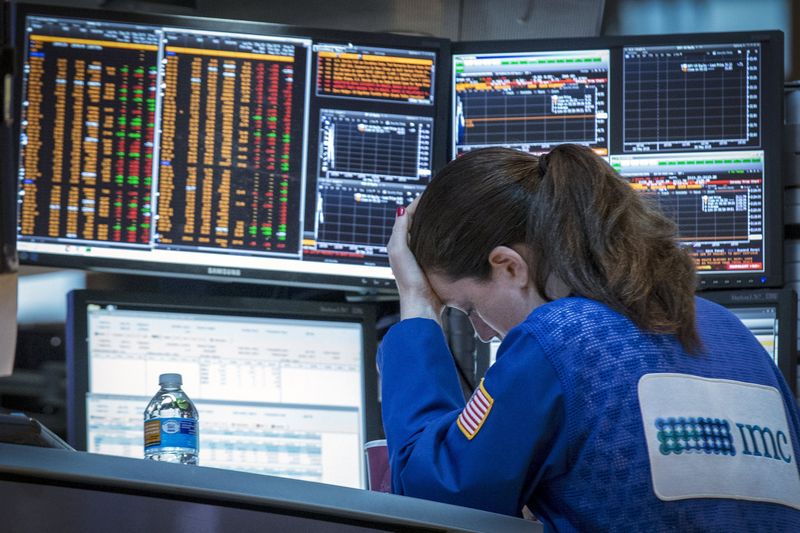Select Language

The S&P 500 suffered its biggest one-day slumped since 2020 after U.S. President Donald Trump announced comprehensive trade tariffs, prompting fears of an all-out trade war that could result in a global recession.
At 4:00 p.m. ET (21:00 GMT), the blue-chip Dow Jones Industrial Average fell 1,679.4 points or 4%, the benchmark S&P 500 plunged by 4.8%, and the tech-heavy Nasdaq Composite fell 6%.
Trump tariffs prompt sharp selloff
President Trump announced sweeping new tariffs on Wednesday, imposing a 10% levy on all imports and significantly higher rates on countries deemed "bad actors."
China faces an additional 34% tariff on top of the 20% duties already in place. The European Union, Japan, and others will see tariffs ranging from 20% to 49%.
The broad tariffs take effect on April 5, with the country-specific hikes starting April 9.
Trump justified the tariffs by citing unfair trade practices and currency manipulation, asserting that these measures would rejuvenate American industries and reduce the national debt.
The "U.S. tariffs announcement was more hawkish than expected, particularly for Europe and China, with rates at 20% and ~54%," said analysts at Barclays, in a note. "Although there may be room for negotiation and many twists ahead, high tariffs and lingering uncertainty raise recession risk. Likely worse before getting better for stocks."
These tariff policies could see U.S. gross domestic product take a 10% hit in the second quarter of 2025, High Frequency Economics Chief Economist Carl Weinberg said in a note Thursday, potentially pushing the world’s largest economy into a recession after a predicted small contraction in the first quarter.
Weinberg estimated that tariffs would take $741 billion out of U.S. household real incomes or corporate profits, or more if fully accounting for all tariffs on aluminum, steel and non-exempt trade with Canada and Mexico.
UBS estimates that if these tariffs remain in place, real GDP could decline by 1.5 to 2 percentage points in 2025, while inflation could approach 5%.
The Swiss bank states that this scenario "has the potential to considerably worsen the growth inflation mix in the U.S. and the global economy in the coming year."
UBS analysts have set a near-term target of 5300 for the S&P 500, but warned in a note to clients that ongoing tariff uncertainty could drive the index below 5000.
Tariffs could hit Apple’s net profit by 14% - Jefferies
A number of the country’s major corporations have been hit hard by the tariffs news, with Apple (NASDAQ:AAPL), down 9%, a prime example given the hefty tariff on China - the base for much of Apple’s manufacturing.
Jefferies analysts warned that proposed U.S. tariffs on Chinese imports could significantly impact Apple’s profitability, estimating a potential 14% reduction in the company’s net profit for fiscal 2025 if it is not granted an exemption.
Shares of big sellers of imported goods were among the hardest hit. Five Below (NASDAQ:FIVE), Dollar Tree (NASDAQ:DLTR) and Gap (NYSE:GAP), for example, all suffered double digit percentage losses.
Retailers were also hit hard, with Nike (NYSE:NKE) and Walmart (NYSE:WMT) slumping after tariffs were imposed on major production hubs including Vietnam, Indonesia and China.
Tech shares also dropped in an overall risk-off mood, with Nvidia (NASDAQ:NVDA) and Tesla (NASDAQ:TSLA) both around more than 7% and 5% respectively.
Jobless claims drop; March jobs report looms
The number of Americans filing new applications for unemployment benefits fell last week, dropping 6,000 for the week ended March 29, pointing to continued labor market stability ahead of potential volatility from import tariffs.
Private payrolls, released on Wednesday, surprised to the upside, while JOLTS job openings disappointed earlier in the week, setting the scene for Friday’s nonfarm payrolls release.
That said, the Federal Reserve’s decision making as far as rate cuts are concerned could well now be determined by the impact on the U.S. economy from the trade tariffs.
Federal Reserve Governor Adriana Kugler said there were "upside risks" to inflation associated with Trump’s policy changes.
But these tariffs will likely dampen near-term growth, increase market volatility, and prompt the Federal Reserve to deliver significant rate cuts later this year, according to UBS.
The bank’s base case scenario assumes rate cuts of 75 to 100 basis points (bps) over the remainder of 2025.
(Peter Nurse, Ayushman Ojha and Scott Kanowsky contributed to this article.)

